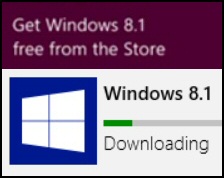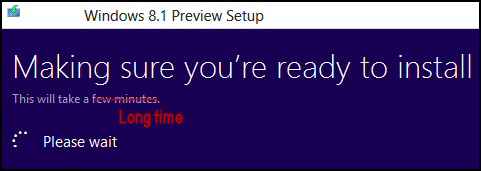Windows 8.1 Installation
Here is an installation conundrum, in the old days there were zillions of menu, yet because their prompts kept us busy, the install seemed quick. These days we can install Windows 8.1 with just a handful of clicks, but due to periods of seeming inactivity, the install seems to take for ever.
How to Get Started with Microsoft Windows 8
- Install Windows 8.1 Preview – Getting Started
- Windows 8.1 Installation Settings
- System Requirements for Windows 8.1
♦
Install Windows 8.1 from Windows 8
Scenario: It's post October 17th 2013, you still have Windows 8, but now you want to upgrade to Windows 8.1 [Blue].
Provided your machine is fully patched with all Microsoft's updates, you will see 8.1 as an App in the Store. All versions of Windows 8, Pro, RT or even the 8.1 preview, start the automated upgrade process from this installer stub in the Store.
The only wrinkle with updating the 8.1 preview version is that you have to reinstall all the Metro Apps.
You will need about 15 MB of free disk space for the installation, and your machine will need up to 3 reboots. I liked the progress bars during the download and the subsequent installation phase, the whole process took me an hour and a quarter.
Tip: Once the install completes go back to the Store, and check if any updates for Windows 8.1 have appeared.
Install Windows 8.1 on Server 2012
You can get the Windows 8.1 desktop, even on Server 2012. Launch PowerShell and run this command:
Add-WindowsFeature Desktop-Experience
This instruction installs the Windows Store, from there you can add Apps. Remember to Run As Administrator.
How to Hide or Remove the Start Button!
My good friend 'Barking Eddie' complained because he wanted to hide the Start Button in Windows 8.1, Eddie wants to revert the cleanness of Windows 8. Unfortunately, nobody has yet found a registry hack, or a configuration setting to revert to remove the Windows 8.1 Start Button.
How to Clean Your Windows 8.1 Start Screen
Get rid of all that clutter by deleting 3 files.
- apps.Folder.itemdata-ms
- apps.Folder.itemdata-ms.bak
- apps.FolderLayout.bin
Begin in Windows Explorer, View menu, tick "Hidden Items"
Navigate to:
C:\Users\Guy\AppData\Local\Microsoft\Windows
Now you can see the three files to delete (See screenshot below).
Finally, you will need to restart your computer to see the clean Start screen.
Note: This Preview Version was Superseded in October 2013
Install Windows 8.1 Preview – Getting Started
- Get an ISO copy of Windows 8.1. The good news is that Windows 8 (original) can mount an ISO file without installing additional software.
- Tip: if you don't have a second local volume then copy the ISO file to a USB flash drive.
- It's a trivial task to find the 'Setup' file and kick-off the installation.
- It's worth checking online for any updates.
- Research the product key. Win 8.1 requires a genuine product key. The preview version installs with this 20 digit string: NTTX3-RV7VB-T7X7F-WQYYY-9Y92F.
- Making sure you're ready to install took ages on my machine

- Eventually it moved to the next stage: 'Ready to install'
- When I clicked 'Install', setup obeyed and displayed:
Installing Windows 8.1
Your PC will restart several times. This may take a while.
(Mine stayed on 40% for ages)
Windows 8.1 Installation Settings
Guy Recommends: A Free Trial of the Network Performance Monitor (NPM) v11.5
v11.5
SolarWinds’ Orion performance monitor will help you discover what’s happening on your network. This utility will also guide you through troubleshooting; the dashboard will indicate whether the root cause is a broken link, faulty equipment or resource overload.
What I like best is the way NPM suggests solutions to network problems. Its also has the ability to monitor the health of individual VMware virtual machines. If you are interested in troubleshooting, and creating network maps, then I recommend that you try NPM now.
Download a free trial of Solarwinds’ Network Performance Monitor
Windows 8 Post Install Setup
You get the full set of installation options in the final phase of setup. The key decision is ‘Express’ or ‘Customize’, I hit customize just to see the choices.
- Select Wireless
- Settings
- Share
- Windows Update!
- Metadata and device apps On
- SmartScreen filter
- Spynet
- Troubleshooting
- Keyboard Layout (Useful for UK)
- Windows Live Email
- Passwords!
Windows 8 Accounts
You have two choices of logon methods: New Microsoft Account or traditional domain or local account. I accessed ‘User accounts’ via the Control Panel and added more users.
System Requirements for Windows 8.1
You need the same specification as Windows 8, also a Windows 7 machine will be perfectly adequate.
- Processor – 1 GHz
- RAM – 2 MB 64-bit
- Disk Space – 20 GB for the operating system
- Graphics Adapter – At least Microsoft DirectX 9
- Resolution of 1366 x 768 to get ‘Snap Apps’
- DVD – To install your Microsoft operating system.
Recommendations: Install Windows 8 in a Virtual Machine, or alternatively, use an old laptop as a test machine. To really get to grips with the Metro-style UI install Windows 8 on one of these systems: HP Elitebook 2760p convertible, ASUS EP121 tablet or a Dell Inspiron Duo convertible.
Good News: These Virtual Machines Are Supported
- Hyper-V in Windows Server 2008 R2 or later.
- VMware Workstation 8.0 for Windows
- VirtualBox 4.1.2 for Windows
Beware: Window 8.1 won’t install here: Microsoft Virtual PC, Windows 7 XP Mode VMware Workstation 7.x or older. The reason is they don’t support Hypervisor Type 1.
Dual Boot Option: If you have a second partition of at least 20 GB then you could install Windows 8.1 there. The result would be:
C: \Old Operating System
D: \Windows 8.1
Please think through how to preserve any existing files on that second partition before allowing the Windows 8 install to format the D: partition. Once you have installed Windows 8, pay close attention to menu choices as soon as the machine powers on.
What's New in Windows 8.1 (Blue)
- Boot to desktop (Swerve the Start screen)
- Start Button
- Smart Search (Search Once. Go Anywhere.)
- SkyDrive integration. (Also SkyDrive App)
- Supports more devices, for example: latest screens, improvements in battery life and fractionally better performance.
- Encouragement to use SkyDrive.
- Windows Store is improved. Nearly 100,000 apps. Lookout for new Bing apps.
- IE 11 Enhanced Protected Mode (EPM) by default.
- Fingerprint recognition for laptops.
- Assigned access – security feature for apps.
Next Install Windows Server 8 »
Summary: Installing Your Windows 8.1
- Research a URL to download the Windows 8 .iso file.
- No need for an ISO burner, Windows 8 has one built-in.
- If you have a USB flash drive, then this is a good install medium.
- Prepare a test computer, or a virtual machine.
- You need a product key for this installation.
If you like this page then please share it with your friends
Microsoft Windows 8 Features
• Windows 8.1 Blue • Features for Windows 8.1 'Blue' • Windows 8.1 Install
• Windows 8 Overview • Windows 8.1 IE 11 • Windows App Store • Windows 8 PDF Reader
• Windows 8 Configuration • Windows 8 Remote Desktop • Windows 8 Keyboard Shortcuts





